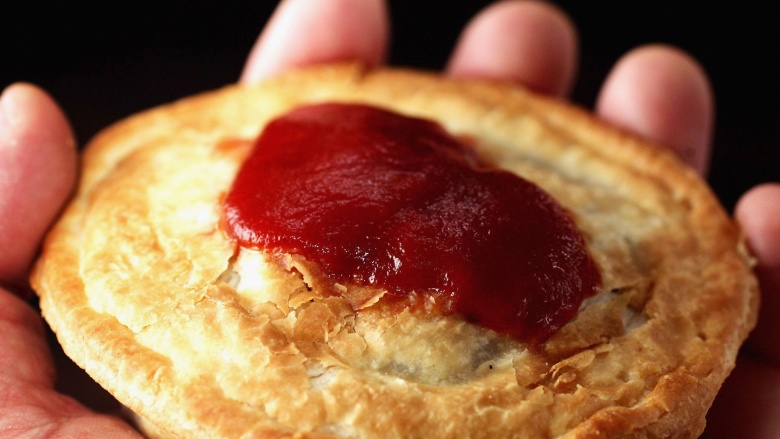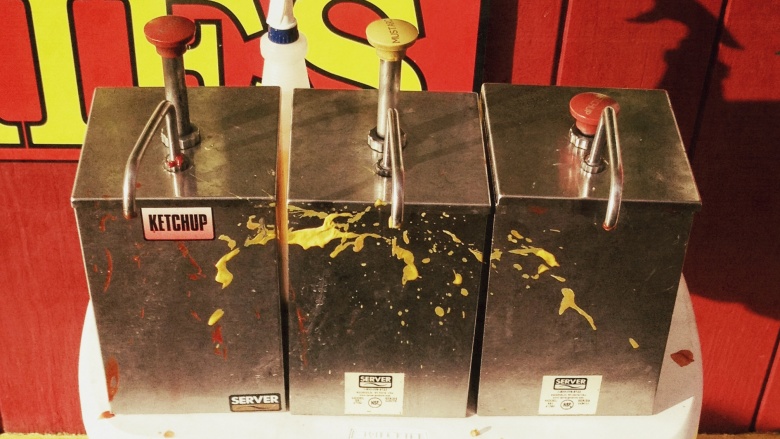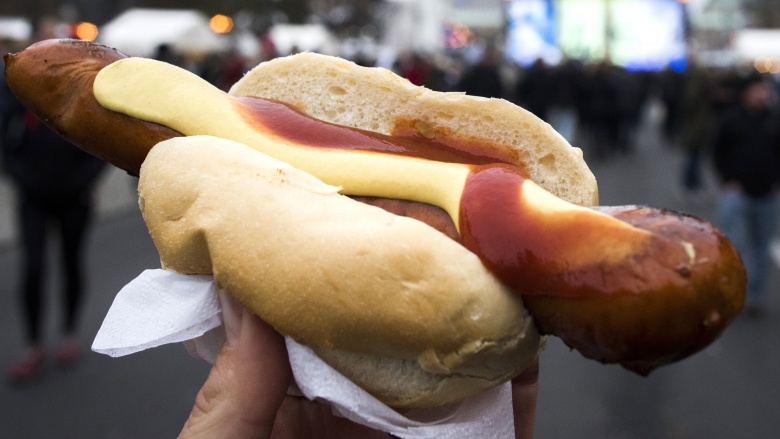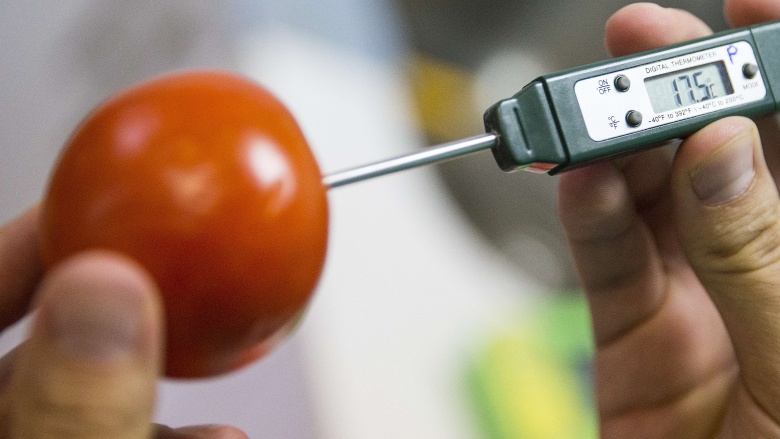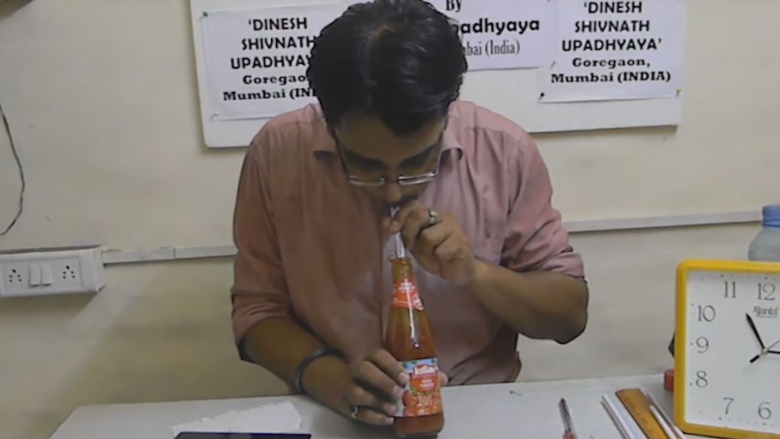Crazy Ketchup Facts You Probably Didn't Know
Ketchup might seem like a product of the modern age, but the truth is it just moves with the times. Ketchup started out its life as a kind of fish sauce in Asia 1,500 years ago that was mainly used as an ingredient instead of on the side. These days, it's used mainly as a condiment...except, of course, in student dorms where it occasionally subs for tomato sauce on pasta. Ketchup has also become largely synonymous with fast food and bad taste, leading to snobbish reactions from chefs when it is applied to their food. But here's the truth: there's more to ketchup than the red goop that meets the eye.
Ketchup please, hold the tomatoes
Back in the day before ketchup went west, it was never seen in the company of tomatoes. The stuff preferred anchovies, walnuts, mushrooms, and kidney beans, among other things. In fact, it sometimes played the part of the starting point for a quick and easy recipe, a role filled more often by cream of mushroom soup today. "Ke-Tsiap," as it was first known, went through a lot of partners on its way to the US. But it wasn't until the year 1812 in Pennsylvania where the first tomato ketchup recipe was written down by James Mease, and thus was born the condiment that chefs love to hate.
Feed the world
Ask anyone to name a brand of ketchup, and nine times out of ten (maybe more) the name they say is Heinz—and that's because Heinz makes a lot of ketchup. Heinz makes so much ketchup in fact that—just counting single serve packets—they make almost enough each year to give everyone on earth two servings. Indeed, 11 billion packets of ketchup is a hell of a lot of ketchup. Throw in the bottles (glass and squeezy), and those big jugs with the pump on top at the hot dog stand, and you could probably float an aircraft carrier—which would make for a pretty creepy photo.
Three percent unpopular
So we've established that Heinz makes a lot of ketchup, and since they're not the only producer in the United States by a long way, you're probably asking "who is eating all that ketchup?" And 97 percent of the time the answer would be...you. That's because the slow red stuff can be found in 97 percent of homes in the US: but the impressiveness of that number is slightly overshadowed by the very nearly literal mountain of french fries that must exist to explain how Americans consume 78 million gallons of ketchup every year.
Ketchup, catsup, and President Reagan
Ketchup and catsup are pretty much the same thing, except that ketchup might be a vegetable—well, in the 1980s at least. As a result of government budget cuts, schools were having trouble meeting the nutritional requirements for the food they were giving the kids. And so the USDA under President Ronald Reagan created regulations that basically said that anything that had the nutritional content of a vegetable could be considered one for the purposes of school lunches, and that included ketchup. There was an uproar: not least among the producers of catsup, which while virtually identical to the big K, nevertheless wasn't blessed with the new status. Fearful of missing out on a piece of the morally questionable action, manufacturers of catsup quickly renamed their product as ketchup, leaving "catsup" forever in its wake.
A veritable sea of condiments
It may seem hard to beat 78 million gallons of ketchup, but in a surprising, and somewhat disgustingly viscous twist, ketchup is actually outsold by both mayo and salsa. So if the oceans run dry tomorrow, we could still float three aircraft carriers—but, actually, we'd probably have bigger things to worry about.
Fights cancer, but not wolves
Ignoring all the sugar it contains (about one-fourth of the stuff is made exclusively of sugar, in case you're curious), ketchup actually has the potential to help prevent cancer. That's because despite all the processing and lack of resemblance to a living fruit, there are actually quite a lot of tomatoes in that sauce. Just four tablespoons of ketchup has the equivalent nutritional value as one medium sized tomato, and that includes the antioxidant lycopene (not to be confused with lycanthropy), which as well as fighting cancer also gives tomatoes their color. But you don't need to start chugging ketchup to get the benefit of lycopene, because almost any tomato product will do the business, so long as it's cooked—which means hangovers are still the only thing a Bloody Mary will cure.
Reduced speed limit ahead
Anyone who has tried to get ketchup out of the classic Heinz glass bottle can blame the government for the frustration, because ketchup has an actual legal speed limit. In order to receive a grade A rating, ketchup can flow no faster than seven centimeters (or 2.75 inches) in 30 seconds. The limit used to be nine centimeters in 30 seconds, but it was revised in 1991. Heinz has set their in house speed limit at .028 miles per hour. You can bet there aren't many volunteers to use that speed gun.
It all ads up...
Despite moving to a squeeze bottle in 1983, Heinz Ketchup's slow flow had become so iconic that in 1987 the company made an advertisement out of it, and cast the then unknown Matt LeBlanc as the star. Featuring some classic 1980s tunes, the ad saw LeBlanc placing the classic glass bottle on the top ledge of a building, before heading downstairs to buy a hotdog...which he then holds out just in time to catch the ketchup as it finally escapes. Incomprehensible logic aside, the ad was something of a hit—but if they'd screened it before the revolution of the squeezy bottle, they might have been lynched.
A sucky world record
Left to it's own devices, ketchup doesn't move very fast. But if you use a straw, you can set a world record. In February 2012 in Nuremberg, Germany, television reporter Benedikt Weber set the ketchup drinking world record by sucking up 14 ounces of ketchup in 32.37 seconds. Meanwhile, a dude from India named Dinesh Upadhyaya (pictured) claimed to have beaten Weber's record in 2015—though, Guinness still recognizes Weber as the record-holder as of this writing. A little bit of ketchup on your hot dog is usually a pleasure. But 14 ounces without the dog is pushing it. Just imagine trying that with mayo.
A runaway industry
In the early days of ketchup, the medicinal benefits were somewhat misunderstood—so much so, that in 1835 it was being sold in pill form and was advertised to treat problems like indigestion and diarrhea. The popularity of the pills became so great that pretty soon the idea started being copied by less scrupulous entrepreneurs and the number of illnesses they claimed to treat inevitably expanded into less likely territory. Unfortunately for many a poor pill popper, a large proportion of the imitation tomato pills not only contained no tomatoes, but were in fact laxatives. The loss of confidence in the pills cause the industry to collapse after little more than a decade.


